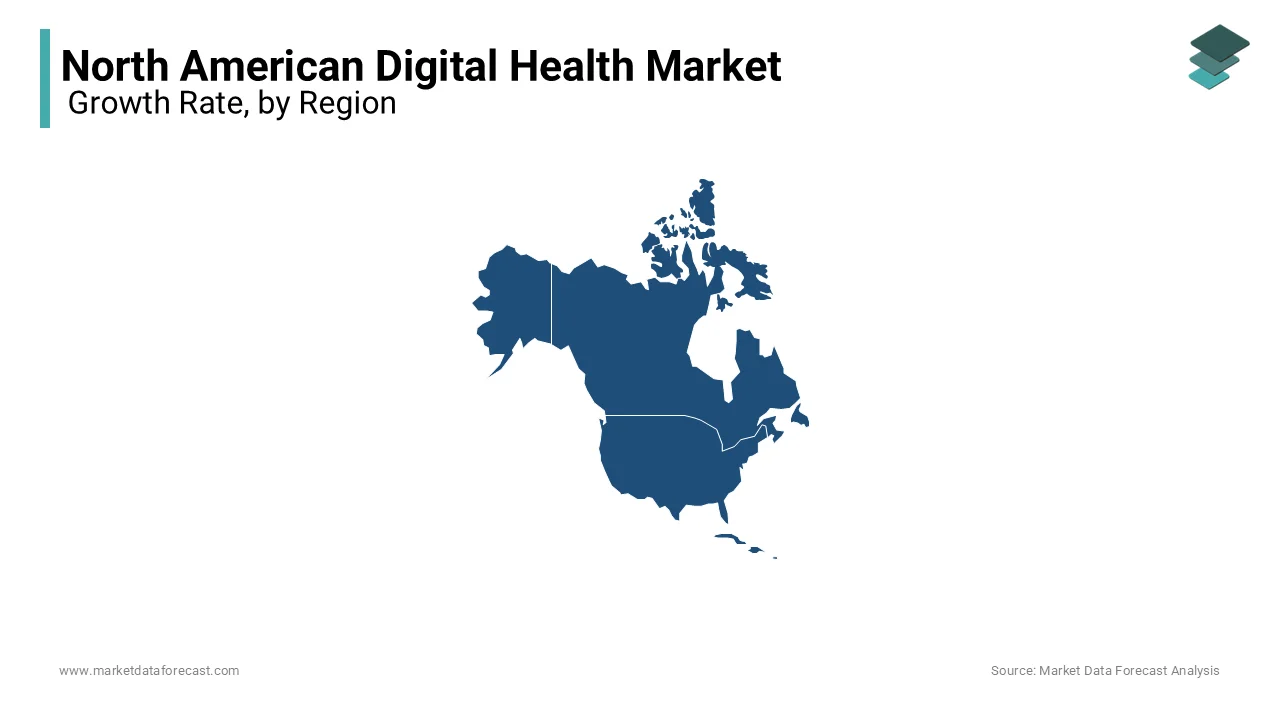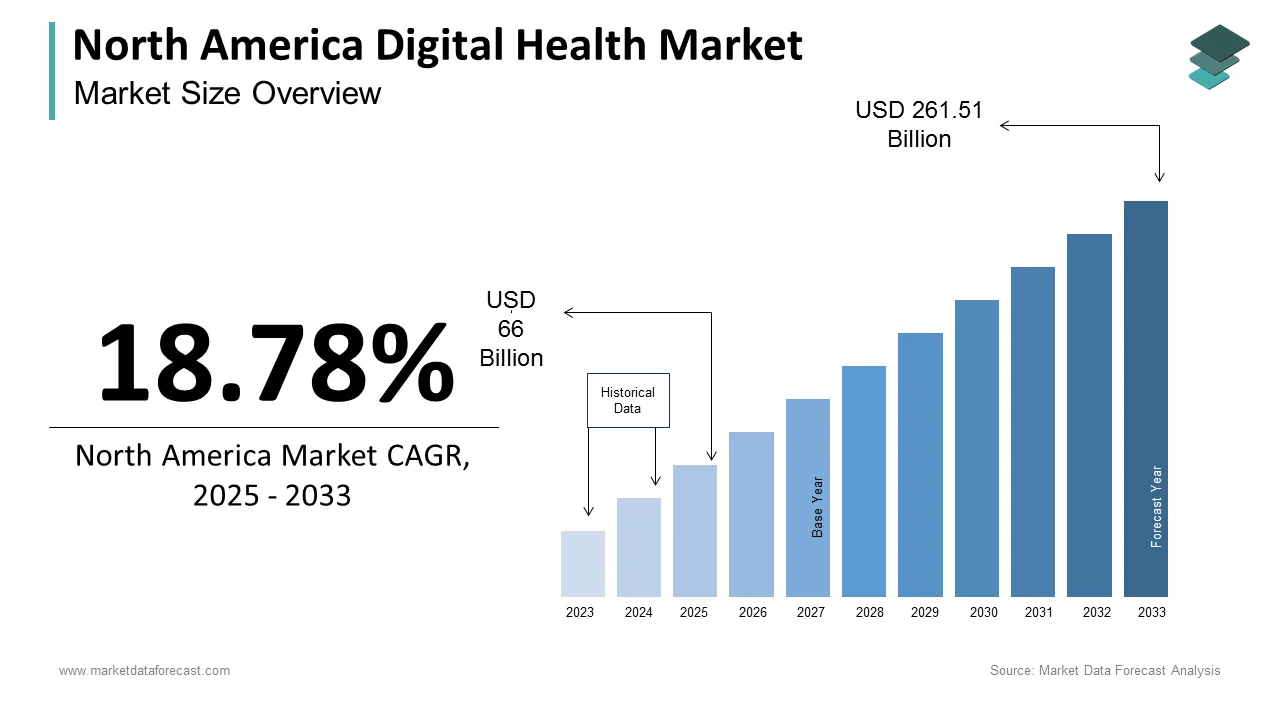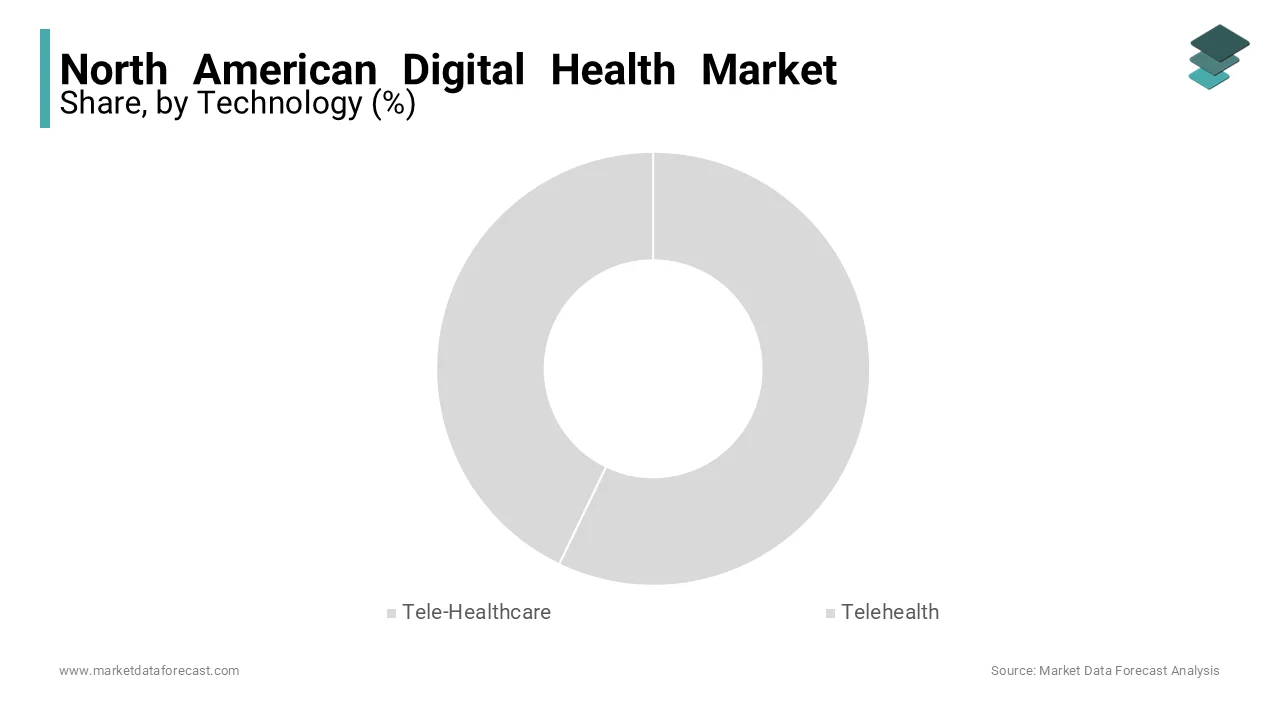North America Digital Health Market Size, Share, Trends & Growth Forecast Report By Technology, Component & Country (the United States, Canada and Rest of North America) - Industry Analysis From 2025 to 2033.
North America Digital Health Market Size
The size of the North America digital health market was worth USD 55.56 billion in 2024. The North American market is anticipated to grow at a CAGR of 18.78% from 2025 to 2033 and be worth USD 261.51 billion by 2033 from USD 66 billion in 2025.
MARKET DRIVERS
Advancing Patient Care through Technology & Connectivity
Digital health combines healthcare methodology with information systems for an enhanced recuperation experience for the patient. Digital health uses advanced innovation, connectivity, and converging information, for example, understanding history and ensuring the quality of treatment administered to its clients.
Growing usage of wearable medical devices is anticipated to promote the digital health market in the North American region. For instance, most patients suffering from CVDs use a wearable device to track their health and stroke-related symptoms, which helps with the immediate consultation of the doctor online or offline for first aid. According to a recent report published by the National Health Council, chronic diseases affect approximately 133 million Americans, 40% of the population. Diabetes patients also use wearable devices to record the glucose level in the body. These wearable devices are connected to the smartphone, which stores the data and sends it to the healthcare provider for any treatment changes. Nearly 90% of Americans use smartphones due to increased internet penetration and their usage for doing several works at public convenience.
mHealth & Smartphone Use Driving Digital Health Growth in North America
Growing mHealth applications in smartphones is another key factor propelling the market growth. The mobile applications are being built with the ability to track the person's health and help maintain their activities on time to develop digital platforms at every end. In addition, increasing health consciousness among the North American people due to increasing infectious diseases and convenience associated with mobile health applications to keep a check on health viral are paving the way for the digital health market forward in this region.
A growing number of smartphone users across the region is one of the key factors propelling the growth of the North American digital health market. According to Statista, the number of smartphone users in the United States is anticipated to reach 307 million by the end of 2022. People are now using smartphones to access their health data by analyzing them and taking adequate precautions to stay healthy and avoid health difficulties. Smartphone manufacturers are advancing their products by introducing innovative features. For instance, Apple developed fitness+ services that track vitals using sensors and works like a fitness tracker.
Aging Population and Digital Health Adoption Propel Market Growth in North America
YOY growth in the aging population among North American countries is another major factor driving the market growth. According to the U.S. Census Bureau, nearly 17% of the population will be aged above 60 in 2021, which will increase by 2030. With increasing age, the older population faces several health issues such as obesity, cardiovascular diseases, Alzheimer's disease, diabetes, etc. Recently, digital health technologies have increased rapidly to aid older adults and help them maintain a healthy life without dependency. Most manufacturers focus on several digital health solutions developed to support old people; these digital tools are known as Gerontechnology. These technologies help older people for the completion of their daily activities.
The increasing adoption of digitalization in the healthcare sector primarily accelerates the growth rate of the digital health market in North America. Hospitals' transformation towards digital is growing aggressively, and automating a few tasks using digital technology is reducing human effort. Compared to manual records, the patient data stored in the software has given more demand to digital technology. Using EHR in hospitals brings more changes in hospital development by helping to store all the patient data related to the hospital, its infrastructure, and the reports to provide quality treatment to the patients. Furthermore, factors include rising healthcare costs, government intervention in improving patient care quality, and healthcare services.
MARKET RESTRAINTS
Regulatory Challenges and Data Privacy Concerns Restrain North American Digital Health Market Growth
However, stringent regulatory norms in the United States and the threat of data privacy are hindering the market's growth. In addition, a lack of awareness regarding the benefits of adopting digital healthcare services hinders North America's market growth rate. Furthermore, the premium costs associated with some healthcare applications and software used for digital health are key factors restraining the market growth. In addition, data privacy is a significant issue in digital technology, which hampers market growth.
REPORT COVERAGE
|
REPORT METRIC |
DETAILS |
|
Market Size Available |
2024 to 2033 |
|
Base Year |
2024 |
|
Forecast Period |
2025 to 2033 |
|
Segments Covered |
By Technology, Component, and Country. |
|
Various Analyses Covered |
Global, Regional & Country Level Analysis, Segment-Level Analysis; DROC, PESTLE Analysis, Porter's Five Forces Analysis, Competitive Landscape, Analyst Overview of Investment Opportunities |
|
Countries Covered |
United States, Canada, and the Rest of North America. |
|
Market Leader Profiled |
Apple Inc., AirStrip Technologies, Google Inc., Orange, Allscripts Healthcare, LLC, Mckesson Corporation, Athenahealth Inc., At&T Inc., Biotelemetry, Inc., Cerner Corporation, Cisco Systems, Inc., Koninklijke Philips Nv, Eclinicalworks, Ihealth Lab, Inc., General Electric Company, and Others. |
SEGMENTAL ANALYSIS
North America Digital Health Market Analysis By Technology
- Tele-Healthcare
- Telecare
- Activity Monitoring
- Remote Medication Management
- Telehealth
- LTC Monitoring
- Video Consultation
- Telecare
- mHealth
- Wearables
- BP Monitor
- Glucose Meter
- Pulse Oximeter
- Sleep Apnea Monitors
- Neurological Monitors
- Others
- Apps
- Medical Apps
- Fitness Apps
- Wearables
- Health Analytics
- Digital Health Systems
- Electronic Health Records
- E-Prescribing Systems
North America Digital Health Market Analysis By Component
- Hardware
- Software
- Services
REGIONAL ANALYSIS
- The United States
- Canada
- Rest of North America
Geographically, the North American digital health market is forecasted to witness a healthy CAGR during the forecast period, owing to the increasing healthcare expenditure and growing awareness around digital health. Besides, government help and joint efforts with app developers and healthcare providers concoct better advanced digital solutions.

The U.S. digital health market accounted for the largest share of the North American region in 2024, owing to the high prevalence of chronic diseases. In 2016, the U.S. government health IT invested approximately 1.3 billion to develop new mobile healthcare applications. In October 2019, American Well partnered with Cleveland Clinic to form a new joint venture, 'The Clinic'. The objective of this venture is to provide virtual healthcare services to patients who are not able to visit healthcare centers. Many COVID-19 cases are one driving factor as people opt for various digital health services for diagnosis and treatment. On July 13, 2020, Allscripts and Microsoft announced the augmentation of their long-standing vital collaboration to empower the extended turn of events and delivery of cloud-based well-being IT solutions.
The Canadian digital health market is estimated to hike at a steady CAGR from 2025 to 2029. Canada ranks fourth in global health and biosciences centers. There is a narrow window of opportunity to exploit its innovation investments and these global trends. Emerging digital technology is a relative term, capturing new technology currently being developed or developed over the next five to ten years. These are the opportunities estimated to accelerate the adoption and use of emerging digital health technologies in Canada. In Canada, the Digital Health Canada association helps to connect and empower digital health professionals through the information and technologies that help people achieve quality treatment. The key player in this region is developing advanced technologies that help the digital health market demand in this region.
KEY MARKET PLAYERS
Some of the companies playing a promising role in the North American digital healthcare market profiled in this report are Apple Inc., AirStrip Technologies, Google Inc., Orange, Allscripts Healthcare, LLC, Mckesson Corporation, Athenahealth Inc., At&T Inc., Biotelemetry, Inc., Cerner Corporation, Cisco Systems, Inc., Koninklijke Philips Nv, Eclinicalworks, Ihealth Lab, Inc. and General Electric Company.
Frequently Asked Questions
Which countries contribute the most to the digital health market in North America?
The United States is the largest contributor to the North American digital health market, followed by Canada.
What are the key drivers of growth in the North American digital health market?
The increasing adoption of electronic health records (EHR), rising demand for telehealth services, and a growing emphasis on patient-centric care are key drivers of growth in the North American digital health market.
How has the COVID-19 pandemic impacted the North American digital health market?
The COVID-19 pandemic has accelerated the adoption of digital health solutions in North America, particularly telehealth services, due to increased demand for remote healthcare options.
What trends are emerging in the North American digital health market in 2023?
Emerging trends include the integration of artificial intelligence (AI) in healthcare, wearable technology for remote patient monitoring, and the expansion of virtual care services.
Related Reports
Access the study in MULTIPLE FORMATS
Purchase options starting from
$ 2000
Didn’t find what you’re looking for?
TALK TO OUR ANALYST TEAM
Need something within your budget?
NO WORRIES! WE GOT YOU COVERED!
Call us on: +1 888 702 9696 (U.S Toll Free)
Write to us: sales@marketdataforecast.com


